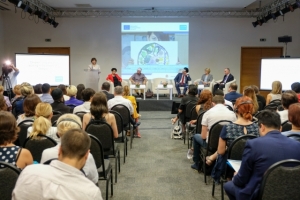UNICEF: Children Living and Working on the Streets of Georgia
On July 24, a presentation on ‘Children Living and Working on the Streets of Georgia’ was held at EXPO Georgia. According to the new study by UNICEF, poverty, family dysfunctionality, violence in families and parents’ migration were all major factors contributing to children ending up on the streets.
The study presents a qualitative study and analysis of children living and/or working on the streets of Georgia. It provides detailed information on the current situation and tailored strategies for children at risk of living on the streets. The aim was to develop the appropriate response mechanism, particularly focusing on prevent mechanisms for children who are at risk living or working in the streets.
As Laila O. Gad, UNICEF Representative to Georgia, mentioned, “It is an opportunity for us to also look at what Georgia is doing in terms of compliance with International Standards and a reference to an action plan to children living and working in the streets. This is a call to action to make sure that there are strong responses and rehabilitation, so children are not deprived of their basic rights”.
“It is our duty as parents and as a society to protect children who are vulnerable. The EU is very keen to support the initiative, because protection of children, both from a protective side and through the responsive mechanisms outlined in the study, is vital," noted Catalin Gherman, Deputy Head of Cooperation Section of EU Delegation to Georgia. "There has to be a very strong system in place for the responsive strategy to be successful."
Hans Bederski, Director of World Vision South Caucasus stated that: “When everything else fails, children end up on the streets. It is not a child’s choice to live on the streets. It is not right that they are abandoned on the streets and they deserve a home, a school, primary healthcare. They need social services to be protected from harm and abuse. The research findings now enable us to better tailor prevention and exit strategies for children at risk. The report also highlights the gaps in the system we have in social services”.
The study shows that the population of children living and/or working on the streets of Georgia is highly diverse and includes youth/children who live and work on the streets without protective care from parents, children who spend most of their daytime hours working on the streets and who themselves contribute income to the family, children who are accompanied by adults who are also street workers, and children of migrant street families who are predominantly Roma and Azerbaijani Kurds.
Children who work and live on the street are particularly vulnerable to violence from caretakers. Moreover, the absolute majority of street-connected children do not have access to education nor medical services beyond emergency care.
Differences in social assistance schemes in Georgia and Azerbaijan, as well as different legal frameworks (like prohibitions on begging and stricter enforcement of sanctions against petty trade) and the depreciation of the Azerbaijani currency, lead many Azerbaijani families to migrate to Georgia and resort to a life on the street.
The research reveals that some groups of children live and move together in order to protect each other, to find places to sleep, to create spaces for leisure and entertainment, to cultivate friendship, and to cooperate in economic activities like petty trading, street begging, and petty crime. Other groups of children have internal structures that divide them into seniors/superiors and subordinates. Older children sometimes use younger children below age 14 (subordinate children) as ‘shields’ to avoid criminal prosecution, pushing them to carry out criminal activities and hand over the profits.
Based on the study findings and its recommendations, the Steering Committee worked out country-specific recommendations that entail the development of an overarching vision, strategy, and action plan to ensure adequate prevention and response measures to safeguard children from street life.
Preventative measures includes screening tools tailored to the needs of at-risk children to be used in government families, children to be provided with ID papers at birth and social services to be strengthened. Response measures should take into account availability of services and how to develop them further, especially on the Black Sea Coast. Moreover, establishment and strengthening of social safety nets should be considered as well as funding of NGO services, legal reforms and response of city authorities and police to criminal activities.
The study was conducted by UNICEF Georgia with the support of the European Union and in collaboration with the Ministry of Internally Displaced Persons from Occupied Territories, the Ministry of Labor, Health and Social Affairs, the Ministry of Internal Affairs, World Vision International, the Open Society Georgia Foundation, Caritas Georgia and UNICEF Azerbaijan. It was carried out by Fafo, a Norweigian research institute.
The presentation was opened with welcome speeches by Laila O. Gad, UNICEF Representative to Georgia, Catalin Gherman, Deputy Head of Cooperation Section of EU Delegation to Georgia, Tamila Barkalaia, Deputy Minister of Internally Displaced Persons from Occupied Territories, Labour, Health and Social Affairs Ministry, Natia Mezvrishvili, Deputy Minister of Internal Affairs Ministry, Gocha Lortkipanidze, Deputy Minister of Justice, and Hans Bederski, Director of World Vision South Caucasia. The opening ceremony was followed by a presentation on the research results and recommendations by Ketevan Melikadze, Social Welfare Officer at UNICEF and Steering Committee recommendations by Mari Tsereteli, Head of Guardianship, Custody and Social Programs Department of LEPL Social Service Agency. A Q&A discussion followed shortly after.
By Anna Zhvania












